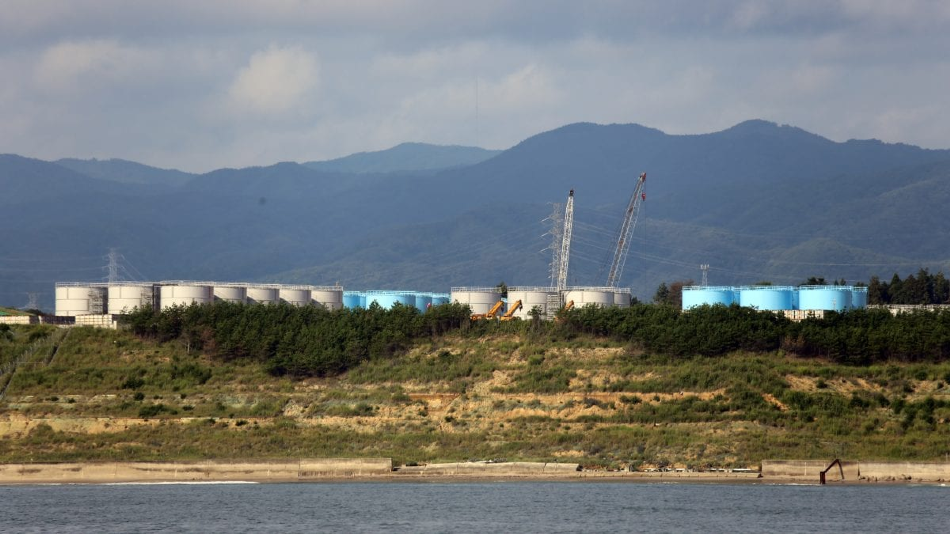Aug 7 2020
Almost a decade after Japan’s Fukushima Dai-ichi Nuclear Power Plant was destroyed by the Tohoku-Oki earthquake and tsunami, which caused the release of radioactivity into the ocean like never before, radiation levels have dropped to safe levels in all but the waters nearest to the closed power plant.
 Some of the more than 1,000 tanks holding treated and untreated wastewater from the Fukushima Dai-ichi Nuclear Power Plant. Image Credit: Ken Buesseler, Woods Hole Oceanographic Institution.
Some of the more than 1,000 tanks holding treated and untreated wastewater from the Fukushima Dai-ichi Nuclear Power Plant. Image Credit: Ken Buesseler, Woods Hole Oceanographic Institution.
Currently, fish and other seafood captured in waters further than all but a restricted region have been identified to be well within the country’s stringent limits for radioactive contamination.
However, a new threat is present and has been burgeoning daily in the number of storage tanks on the land around the power plant, which contains contaminated wastewater.
An article published in the Science journal on August 7th, 2020, analyzes a few of the several radioactive elements included in the tanks and recommends that there is more work to be done to comprehend the possible threats of discharging wastewater from the tanks into the ocean.
We’ve watched over the past nine-plus years as the levels of radioactive cesium have declined in seawater and in marine life in the Pacific. But there are quite a few radioactive contaminants still in those tanks that we need to think about, some of which that were not seen in large amounts in 2011, but most importantly, they don’t all act the same in the ocean.
Ken Buesseler, Study Author and Marine Chemist, Woods Hole Oceanographic Institution
Since 2011, Buesseler has been investigating the spread of radiation from Fukushima into and throughout the Pacific. In June 2011, Buesseler mobilized the research group to perform the first international research cruise to explore the initial pathways taken by cesium-134 and -137—two radioactive isotopes of cesium generated in reactors—as they penetrated the strong Kuroshio Current off the coast of Japan.
Furthermore, Buesseler has congregated a network of citizen scientists in Canada and the United States who have helped track the entry into and movement of radioactive material on the Pacific coast of North America.
The researcher is more worried about the greater than 1,000 tanks located on the grounds of the power plant, which have been loaded with cooling water and groundwater that have become contaminated via contact with the reactors and their containment buildings.
Advanced cleaning processes have helped eliminate several radioactive isotopes and measures to deflect groundwater flows around the reactors have immensely reduced the amount of contaminated water being collected to below 200 metric tons per day.
However, according to a few predictions, the tanks could be filled in the near future. Therefore, some Japanese officials recommend that the treated water should be discharged into the ocean to make way for more wastewater.
Tritium, an isotope of hydrogen, is one of the radioactive isotopes and found at the highest levels in the treated water and would be discharged as it is nearly impossible to eliminate. This is because it tends to become a part of the water molecule itself.
But tritium has a comparatively short half-life—which is the measure of the decay rate of an isotope—is not easily absorbed by seafloor sediments or marine life, and generates beta particles, which is not so detrimental to living tissue as other forms of radiation. Isotopes that tend to stay in the treated wastewater are strontium-90, cobalt-60, and carbon-14.
These isotopes and the others that were left out, which were unraveled only in 2018, decay very slowly and have much higher affinities for seafloor sediments and marine organisms such as fish, which means they could be dangerous to humans and the surroundings for much longer and in more complicated ways compared to tritium.
The current focus on tritium in the wastewater holding tanks ignores the presence other radioactive isotopes in the wastewater. It’s a hard problem, but it’s solvable. The first step is to clean up those additional radioactive contaminants that remain in the tanks, and then make plans based on what remains.
Ken Buesseler, Study Author and Marine Chemist, Woods Hole Oceanographic Institution
Buesseler added, “Any option that involves ocean releases would need independent groups keeping track of all of the potential contaminants in seawater, the seafloor, and marine life. The health of the ocean—and the livelihoods of countless people—rely on this being done right.”